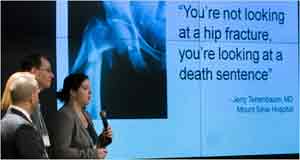Osteoporosis Drugs Compared for Side Effects, Efficacy
 A study comparing the efficacy and tolerability of two popular osteoporosis drugs, denosumab and zoledronic acid, found that denosumab had a significantly greater effect on increasing spine bone mineral density and zoledronic acid caused more flulike symptoms. These findings were presented recently at the American Society for Bone and Mineral Research’s annual meeting.
A study comparing the efficacy and tolerability of two popular osteoporosis drugs, denosumab and zoledronic acid, found that denosumab had a significantly greater effect on increasing spine bone mineral density and zoledronic acid caused more flulike symptoms. These findings were presented recently at the American Society for Bone and Mineral Research’s annual meeting.
Researchers performed a retrospective chart review and survey of 107 patients to compare the efficacy, patient satisfaction, cost and known adverse effects of denosumab versus zoledronic acid, including muscle pain, back pain and flulike symptoms. The denosumab and zoledronic acid groups were statistically similar in all areas but spine bone mineral density (increased 0.060 g/cm2 versus 0.021 g/cm2, respectively) and flulike symptoms (none versus 29 percent of patients).
“Both groups of patients were satisfied with their treatment despite the discrepancies in the drugs,” said Kellen Sheedy, first author and Stritch School of Medicine student.
The FDA approved denosumab in 2010 for postmenopausal women with osteoporosis. It is injected subcutaneously (60 mg) every six months. The treatment works by inhibiting bone loss and fracture risk.
Zoledronic acid was approved by the FDA in 2007 for osteoporosis. This treatment is administered intravenously (5 mg) once every 12 months. It is the most potent of the drugs in its class, and it works by interfering with the bone-breakdown process.
“This study helped us quantify the efficacy and adverse effects of these two drugs providing further guidance for physicians who prescribe these treatments,” said Pauline Camacho, MD, study investigator and director of the Osteoporosis & Metabolic Bone Disease Center at Loyola University Health System. “While this was the first head-to-head comparison of these two treatments, larger prospective studies will be needed to confirm these findings.”
Source Newsroom: Loyola University Health System

